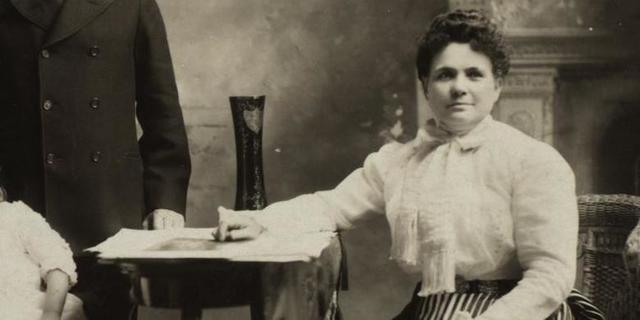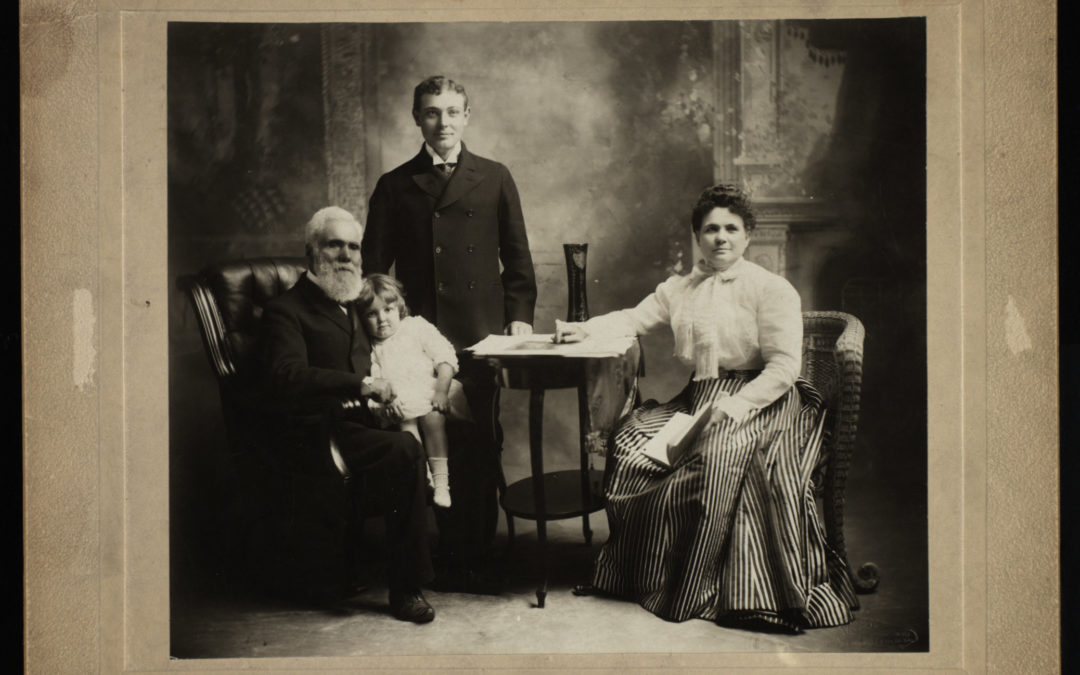
Lead image of Elizabeth McCune from history.lds.org.
This article by Kathryn Jenkins Gordon appeared in the 22 June 2016 online edition of LDS Living Magazine.
Let’s consider a woman who really “took one for the sisters.” If you’ve ever visited Salt Lake City, you are likely familiar with the McCune Mansion—the extravagant, red sandstone, 21-room manor perched on a hill just off Main Street. It was originally built as a home for Latter-day Saints Alfred and Elizabeth Ann Claridge McCune, who reared some of their nine children there.
Its affluent and elaborate design was a far cry from the more modest, humble homes in Nephi, Utah, where Elizabeth Ann grew up. It’s an even greater leap going from the humble lifestyle of a Mormon missionary in the streets of London to being grande dame of such a mansion, but that’s exactly what Sister McCune did. And she did it all despite a husband who decided later in life that he wanted to leave the Church.
On July 1, 1872, Elizabeth Ann Claridge married her high school sweetheart, Alfred William McCune, in the Endowment House in Salt Lake City. Alfred spent the next three or four decades building an incredibly successful career in railroad and mercantile ventures, resulting in him becoming one of the wealthiest men not just in Utah, but in the West. Sadly, along the path to wealth, he lost interest in the faith he and his wife had grown up with.
Not so for Elizabeth, who was always busy working on projects of her own. In 1905, she was appointed by Governor William Spray to be a trustee of the Utah State Agricultural College (later Utah State University) in Logan. For the last two of her ten years of service at the college, she acted as vice president. As far as Church service was concerned, she was a temple worker in the Salt Lake Temple and a genealogy expert who traveled twice to Europe to gather genealogical records. She served as a member of the general board of the Young Women Mutual Improvement Association, a member of the Church’s Genealogical Society, and in 1911 she was called to the Relief Society General Board.
A Life-Changing Speech
By the time Elizabeth turned 45 years old, she was the mother of seven. Her 19-year-old son, Raymond, was serving a full-time mission for the Church in Great Britain when Alfred decided to take his family on an extended European trip. Elizabeth was thrilled at the chance to meet up with her son along the way. She even invited Raymond and some of the other missionaries to stay in the house the McCune family was renting in England. The Elders held regular street meetings on a beachside promenade, and Elizabeth and her daughter Sarah Fay became habitual participants.
On October 28, 1897, the Saints from the London area assembled at Clerkenwell Town Hall for the Church’s semi-annual London Conference. Mission President Rulon S. Wells and his counselor, Joseph W. McMurrin, took turns addressing those present. Sister McCune remembered it as a hall bursting at the seams with “saints and strangers” and “some very distinguished people.”
During the afternoon session, President McMurrin decided to address an outspoken anti-Mormon head-on, speaking about the falsehoods the man and his daughters were spreading about Mormon women being confined in ignorance and degradation. Sitting in her seat, Elizabeth thought, Oh, if we only had one of our good woman speakers from Utah to take advantage of this grand opportunity what good it might do! Little did she know that she would soon be that speaker.
The thought had scarcely crossed her mind when President McMurrin pointed to her and announced, “We have with us just now, a lady from Utah who has traveled all over Europe with her husband and family, and hearing of our conference, she has met with us. We are going to ask Sister McCune to speak this evening and tell you of her experience in Utah.”
Surveying her audience, she started with boldness. She later recorded: “I told them I had been raised in Utah and knew almost every foot of the country and most of the people. I spoke of my extensive travels in America and in Europe, and said that nowhere had I found women held in such esteem as among the Mormons of Utah.
“Our husbands are proud of their wives and daughters; they do not consider that they were created solely to wash dishes and tend babies,” she continued, “but they give them every opportunity to attend meetings and lectures and to take up everything which will educate and develop them. Our religion teaches us that the wife stands shoulder to shoulder with the husband.”
Sister Elizabeth McCune, the visitor from Utah and mother of seven, had done more in a few sentences to put down the dissenters than had all the Elders combined. When the meeting drew to a close, she was mobbed by strangers who wanted to compliment her and ask her questions. One told her, “I have always had a desire in my heart to see a Mormon woman and to hear her speak. Madam, you carry truth in your voice and words.”
A Major Change to Missionary Work
President McMurrin thought about Elizabeth and her captivating effect on audiences so much that he wrote to the First Presidency. His plea was straightforward: that if “a number of bright and intelligent women were called on missions to England, the results would be excellent.”
On March 11, 1898, after some discussion, the First Presidency decided to call and set apart single sister missionaries; for the first time in Church history, single women would be given certificates authorizing them to preach the gospel.
At the April 1898 general conference, President Cannon announced the decision to the body of the Church. He noted that while sister missionaries could not administer ordinances, “they can bear testimony; they can teach; they can distribute tracts, and they can do a great many things that would assist in the propagation of the Gospel of the Lord Jesus Christ.”
On April 1, 1898, Amanda Inez Knight and Lucy Jane Brimhall were set apart as the first single, certified, female proselyting missionaries in the history of the Church—in large part due to the way Elizabeth McCune spent her summer vacation and stood for her beliefs.
About Guest Author
Twitter •


 Watch a video about the restoration of the gospel on lds.org
Watch a video about the restoration of the gospel on lds.org